Slideshow
[bit.ly]

One block from my home, in the landmarked Prospect Park South Historic District, Albemarle Road spans six blocks, from Coney Island Avenue to the B/Q subway cut. Albemarle Road is part of the Flatbush Malls, an extended series of streetscape gardens created by some of the developers who carved suburbs out of Flatbush farmland starting in the late 1890s.
A photograph of Albemarle Road as viewed from the train tracks 100 years ago, in 1909.
One of the class projects for my Urban Garden Design class with Nigel Rollings at the Brooklyn Botanic Garden is a written project, for which there were several options. I chose to write about a “local landscape.” And Albemarle Road certainly is that. I’ve been captivated by this landscape since we first started househunting in the area. The more extensive stretches of Flatbush Malls lie south and east of me, along Glenwood Road and East 17th Street. Albemarle Road is a 2-minute walk from my home. It’s given me a chance to inhabit and study this landscape close-hand.
I’ve been photographing Albemarle Road since we moved to the area. I’m compiling more reference material on the history of this landscape and its designer, which I’ll save for a future post. In the meantime, please enjoy these views of Albemarle Road in all four seasons: Winter, Spring, Summer, and – saving what I think is the best for last – Fall.
Much of the character of Albemarle Road is, by design, imparted by the deep private gardens of the front yards. So I’ve also highlighted two properties I’ve photographed at different times of the year, each of which captures, in its own way, the seasonal beauty of Albemarle Road.
Looking west from Buckingham Road, similar to the view in the 1909 photograph, January 2009.
1306 Albemarle Road, December 2008
Composite panoramic view from the corner of Westminster Road
Western end of Albemarle Road, at Coney Island Avenue, April 2008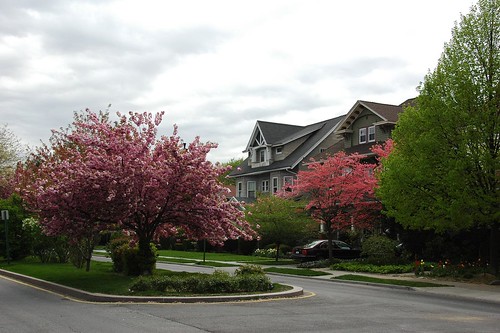
Rugby Road, East side, South of Albemarle Road, April 2007
1314 Albemarle Road, September 2006
1510 Albemarle Road, September 2006
131 Buckingham Road, September 2006
Corner of Albemarle and Marlborough, looking east, November 2007
Corner of Marlborough and Albemarle Roads, looking northwest November 2007
Albemarle Road, looking west from Rugby Road, November 2007
1406 Albemarle Road, October 2006
1423 Albemarle Road, November 2007
1510 Albemarle Road, November 2006. The trees at the left in the adjacent vacant lot were all downed by the Brooklyn tornado of August 2007. It’s now the location of the Flatbush CommUNITY Garden.
On the same block, looking from the other direction, with the vacant lot on the left, on August 8, 2007.
Winter Wonderland, 2009.01.19
The Flatbush CommUNITY Garden, Brooklyn’s (and NYC’s!) newest community garden, 2008.09.16
One Year Ago [Tornado recap], 2008.08.08
Albemarle Road in Prospect Park South featured in the Times, 2008.06.21
Forgotten Flatbush: The Albemarle Road Pedestrian Bridge, 2007.11.25
The south side of Albemarle Road looking east from Rugby Road around 10am this morning.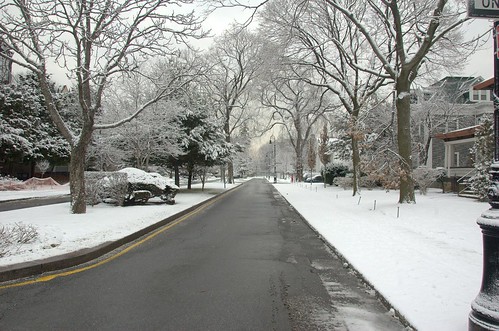
After shoveling and de-icing the steps and sidewalk this morning, I walked over to the landmarked Prospect Park South Historic District for the photo op. I’m glad I did. I was rewarded with these beautiful, snowy images.
I concentrated on Albemarle Road as part of my research into the history of its design and documentation of the current landscape for my Urban Garden Design class at the Brooklyn Botanic Garden. Somebody has to do it.
Looking toward the northwest corner of Albemarle and Rugby Roads
Albemarle Road, South side, looking west from Buckingham Road. Behind the chain link fence on the left lies the Flatbush CommUNITY Garden.
The border of Prospect Park South is delineated by these brick posts surmounted with concrete planters. The street labels have been replaced at least once, having been weathered to near-illegibility from a century of exposure. The monogram is “PPS”: Prospect Park South.
Some of Brooklyn’s famous parrots were flocked high up in the top of this snowy American Elm tree on Albemarle Road. There are three parrots in this cropped image. If I were to produce an invasive species calendar, this would be a good image for it.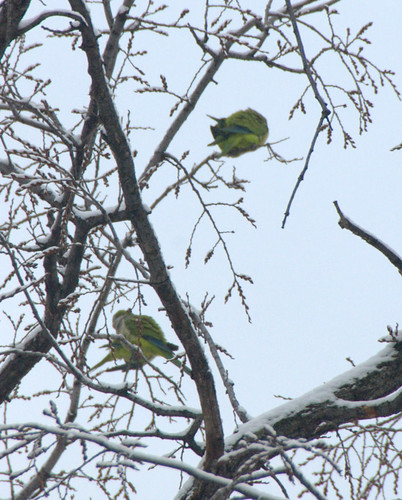
Holly, Flatbush Malls, Albemarle Road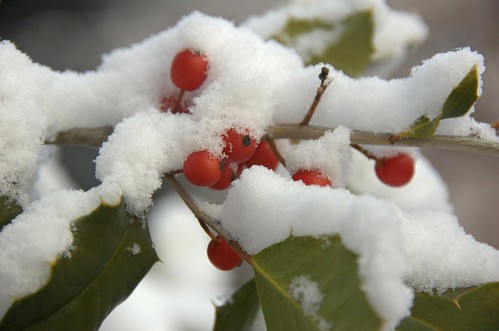
Branches, Flatbush Malls, Albemarle Road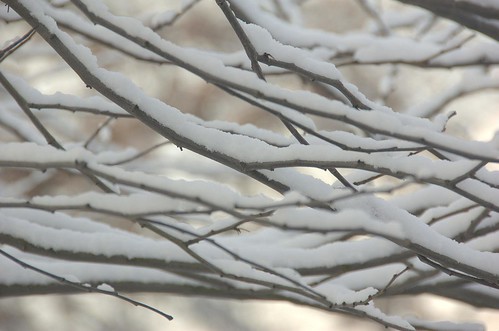
Lantern, 131 Buckingham Road, “The Japanese House”
1406 Albemarle Road / 135 Rugby Road, Prospect Park South, Flatbush, Brooklyn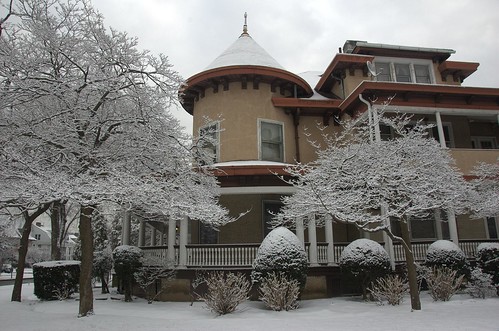
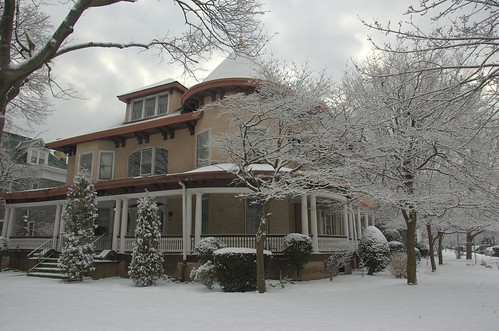
Completed raised bed frames, ready for filling and planting, on August 24, 2008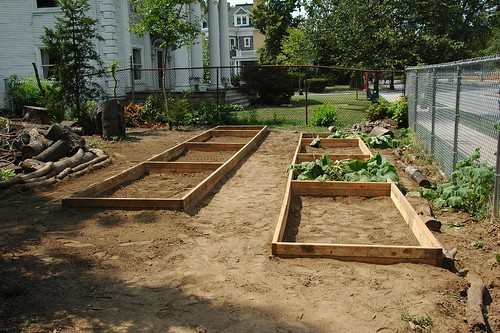
Brooklyn’s newest community garden broke ground at the beginning of July. We planted for the first time two weeks ago. Planning for the garden began at least as early as the Winter of 2007, when I first became involved.
The Flatbush CommUNITY Garden is a project of Sustainable Flatbush. The Garden is located at 1522 Albemarle Road, at the intersection of Buckingham Road, on property generously loaned to the Garden by the owner.
All 16 plots are already allocated for this season. As Brooklyn’s newest community garden, we are still working out our membership procedures. We hope to have these finalized by the end of the year. Announcements for future meetings, and procedures for new members to join, will be posted on the Sustainable Flatbush Web site when they are available.
Site visit, Sunday, June 1, 1008
The mission of the Flatbush CommUNITY Garden is to create space for a diverse group of neighbors to establish a community-led organic garden; to grow fruits, vegetable, herbs, and flowers, and create a multi-cultural, interactive, empowering space that fosters unity and pride within the community while supporting healthy eating and local sustainable agriculture. An additional goal of this program is to promote sustainable gardening and farming practices throughout the neighborhood, especially on publicly accessible land that is currently underutilized. Our gardens will serve as visible examples of sustainability practices such as rainwater harvesting, water-efficient landscaping, composting, and permaculture.
Picking up compost from the Fresh Kills Composting Site on Staten Island
Other posts
My photos of this garden (Flickr set)
Sustainable Flatbush: Community Garden, Projects 2008, and Flickr photo set
Trees snapped in half on Marlborough Road at Albemarle Road, Prospect Park South, on August 8, 2007. This area incurred the most dramatic damage in Flatbush, with scores of trees downed on the street and private property.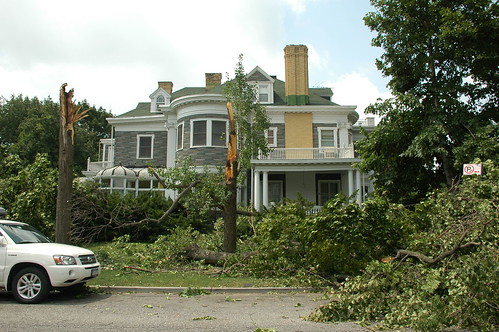
The Brooklyn Tornado of 2007 struck one year ago today.
I featured this house in Conservatory Envy in September 2006. I took this shot in November 2006.
The tree on the right was a casualty of the tornado.
Here’s how it looked from across the street in November 2006. 
Tornado Damage in Prospect Park South, Caton Park and Beverley Square West, August 8, 2007
Tornado Damage, Victorian Flatbush, August 8, 2007 (Flickr photo set)
Albemarle Road, just east of Coney Island Avenue, April 2008
Tomorrow’s New York Times Real Estate section provides a brief history and profile of Albemarle Road in Prospect Park South, a block from my home:
Grandest of all the streets in Prospect Park South is Albemarle Road, a broad, esplanaded boulevard of stately neo-Classical, Queen Anne and Colonial style mansions. In fact, for the three blocks from Argyle to Buckingham Roads, Albemarle is one of the grandest residential streets in the whole city, even with some dings and dents.
– Streetscapes | Albemarle Road: Brooklyn’s Stately Esplanade , Christopher Gray, New York Times, June 22, 2008
I’ll say. Prospect Park South is the most photogenic neighborhood I know in Brooklyn. I’ve got over 100 photos of Albemarle Road alone on my Flickr site.
The greenscape is as impressive as the architecture:
Mr. Alvord created Albemarle Road as his main boulevard, with a planted strip down the middle and a dozen imposing houses east of Argyle Road, most built from 1899 to 1910. They created a most unusual place and were made grander by his main requirement — that no fences, hedges or plantings extend beyond the house lines, so the front yards combine into a unified majestic sweep.
Albemarle Road, looking west from Rugby Road, Prospect Park South, November 2007
The Times fails to credit the man responsible for designing and planting these grand grounds, John Aitkin (or Aiken, I’ve seen both spellings):
Thousands of Shrubs, Plants and Trees to Be Set Out in Flatbush
Dean Alvord, owner, and John Aitkin, landscape gardener of Prospect Park South, the new residence park of Flatbush, have just returned from a tour of the nurseries [of several cities], where selections were made of over five thousand five hundred [5,500] ornamental shrubs, plants and trees for planting this fall. The list comprises rare evergreens and deciduous varieties chosen with reference to symmetry of form, color of foliage and beauty of flower. A foreign order has also been placed for 10,000 Holland bulbs of early spring blooming flowers, tulips, hyacinths, crocus and narcissus [Daffodils].
The form of street decoration carried out in Marlborough, Rugby and other north and south roads in Prospect Park South, will be varied in Albemarle road, where the unusual width will admit of a parkway through the center, with an asphalt driveway on either side. The more dwarf growing ornamentals will be planted in the parkway, and rows of shade trees will line the inside of the sidewalks.
Altogether, this fine residence section will contain the widest variety of hardy ornamentals and herbaceous plants to be found outside of city parks.
– Suburban Ornamentation, The Brooklyn Daily Eagle, September 17, 1899, page 10 [Note: The same item, with slight variations, appeared with the title “Beautifying the Suburbs” on September 4.]
The Flatbush Malls sit within the area known as Victorian Flatbush, named because of the dominant architectural style. In the early 1900s, private developers constructed malls like this one to make the neighborhoods they built more attractive. Malls are common in New York’s outer boroughs. Dean Alvord bought 50 acres of farmland in 1898 to develop Albermarle and Kenmore Terraces. He hired the Scottish landscape architect John Aiken to create a rustic suburban neighborhood within the constraints of the Brooklyn street grid, and the result was largely achieved through the creation of these malls. Extending down the center of Albemarle Road, the Flatbush Malls run from Coney Island Avenue to Buckingham Road, then round the corner and continue one block north on Buckingham Road.
Aiken looked to Commonwealth Avenue in Boston, Massachusetts for inspiration. His mall on Albemarle Road is narrower than the malls on Commonwealth Avenue, as it does not include a central promenade like the one along the Boston street. The original landscaping of the malls featured shrubs and flowers, but did not include trees. The malls are now lined with a mixture of pine and oak trees, holly bushes, and other trees and shrubs, as well as seasonal flowers that grace the intersections. As part of the streets, the malls are owned by the New York Department of Transportation while Parks is charged with the planting design and maintenance.
– Flatbush Malls, Historical Sign, Parks Department
1305 Albemarle Road, Prospect Park South
The Times article highlights a handful of individual homes, including 1305 Albemarle Road, the house I picked out as a good place for a haunting last Halloween:
The most unusual of these dwellings is the one built in 1905 for George E. Gale at 1305 Albemarle, at the northeast corner of Argyle Road, in white clapboard with a colossal two-story Ionic portico. Designed by an architect known only as H. B. Moore, the Gale house has a striking assortment of windows, among them roof dormers with a kind of webbed sash, topped by ebullient broken pediments. On the second floor, there are spider-web-type windows with Gothic-style sashes, and on the rear are leaded glass windows.
Good Place for a Haunting #2, October 30, 2007
Fall Color along Albemarle Road in Prospect Park South, November 21, 2006
Conservatory Envy, September 10, 2006
Albemarle Road, Prospect Park South (Flickr photo collection)
Streetscapes | Albemarle Road: Brooklyn’s Stately Esplanade , Christopher Gray, New York Times, June 22, 2008
Flatbush Malls, Historical Sign, Parks Department
Suburban Ornamentation, The Brooklyn Daily Eagle, September 17, 1899, page 10
In the first Imagine Flatbush 2030 workshop, we enumerated “Assets” and “Challenges”. At our table – and it sounded like the experience was shared at others’ – where someone lived emerged as a primary determinant of what appeared in which category. Sometimes shared concerns, such as transportation, appeared as both an asset and a challenge, depending on where one lived. It became clear to me that the lines can be sharply drawn, sometimes block-by-block.
I’m a newcomer to the area, having moved here only in Spring of 2005. I researched more and more about the area and its history as we committed to buying a home and moving here. I’ve still only visited a small portion of Flatbush. IF2030 is making me curious about exploring more of it.
Part of what I want to explore more of is literally “on the other side of the tracks” from where I make my home. The B/Q subway line runs through this neighborhood as an open trench. There are several places where there is no crossing, and the cut forms a geographical barrier, a steel river, separating one side from the other. It wasn’t always so. With homage to Forgotten NY, here’s a little piece of Flatbush that’s not quite forgotten, still part of living memory, the Albemarle Road pedestrian bridge.
Google Map of the location of the old Albemarle Road pedestrian bridge. 143 Buckingham Road is also highlighted; it’s a landmark in all the historical photos of this crossing. The markers show where I took the photos for this article.
View Larger Map
The BMT as I remember — never rode it much, but had relatives on East 17th & Beverley Road. We would always go to the Albemarle Road footbridge by the tennis courts over the BMT cut, and watch the trains.
– Steve Hoskins, SubTalk Post #93389, NYC Subway
Eastern Dead End of Albemarle Road at Buckingham Road. 143 Buckingham Road is at the left of the photograph.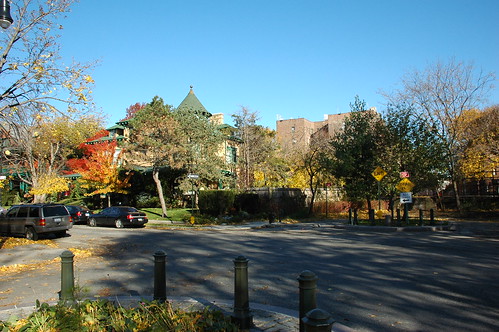
Western foundation of Albemarle Road Pedestrian Bridge
“I seem to have a memory – or is it just a dream? – going back to my earliest childhood, associated with a place about a mile in a different direction from where I lived, towards Prospect Park: it is a stretch of about five blocks of Albemarle Road, going from the Brighton subway underpass to Coney Island Avenue. One got there from our side of the subway tracks by crossing over on a small footbridge. On the far end of the bridge, Albemarle Road suddenly widens, and in the middle of it there is a traffic island, covered with trees and extending a 11 the way to Coney Island Avenue; there are also trees on both sides of the street. My first encounters with this scene are in my memory entirely intermingled with my dreams of it, a recurring vision of overwhelming loveliness at the edge of things, beyond which something entirely new and different must lie.”
– Ronald Sanders, A Brooklyn Memoir, via Living in Victorian Flatbush
Western Dead End of Albemarle Road near East 17th Street. 143 Buckingham Road is at the right of the photograph, across the tracks.
East Foundation of Albemarle Road Pedestrian Bridge. 143 Buckingham Road is in the center, across the tracks.
Albemarle Road is interrupted by the subway cut for the B/Q lines. In the late 19th Century, several rail lines were developed to take passengers from the City of Brooklyn, what we now think of as downtown Brooklyn, through the other villages and towns such as Flatbush, to the beach resorts on Coney Island and Brighton Beach. By the 1870s the Brooklyn Coney Island Railroad ran along Coney Island Avenue. By the 1890s, the Brooklyn, Flatbush and Coney Island Railroad (BF&CI) ran along what is now the current route of the B/Q subway line. Most of Flatbush was still farmland at the time. When the Flatbush farms were sold and the area was developed at the turn of the 20th Century, the tracks still ran at grade.
In this 1873 map of Flatbush, Prospect Park and the Parade Grounds are already laid out to the north, and the Brooklyn Coney Island Railroad runs along Coney Island Avenue. On this map, Parkside Avenue is named Franklin Avenue, Church Avenue is named Church Lane, and Cortelyou Road is named Turner Harrow (or Narrow?) Lane. The Waverly Avenue shown on this map no longer exists; it’s later replaced by Albemarle and Beverly Roads Road, whose future locations are shown, but neither named nor yet built. The future route of the B/Q line is not shown. The families whose landholdings and houses appear on this map lent their names to several streets and neighborhoods: Turner, Hinkley, Ditmas and Vanderveer.
In an 1888 USGS Survey Map of Brooklyn, just a small portion of which is shown here, Waverly Avenue has been “de-mapped.” The roads built in its place, unnamed on this map, are Avenues B and C; these will be renamed later to Beverly and Cortelyou Roads. Between them run East 11th through East 14th Streets; in the early 1900s, these will be renamed to Stratford, Westminster, Argyle and Rugby Roads to cash in on the cachet of Prospect Park South. The BF&CI, which began service in July 1878, is also now in place. East of that, the eastern half of Avenue A (Albemarle Road) has been built, along with East 17th through 19th Streets.
Through the early 1900s, all these railroad lines ran at grade, at street level. There were also trolley lines, at first horse-drawn, then later electrified, on many of the crossing streets. Development brought a burgeoning residential population, more traffic, and more traffic conflicts and accidents. The decision was made to separate the rail and street traffic by moving them to different levels, passing above and below each other.
This photo from the 1918 “Reports of the Brooklyn Grade Crossing Elimination Commission” shows the Albemarle Road Footbridge. The line has been widened to four tracks and now runs below grade. Today, the local Q train runs on the outer tracks, while the express B runs on the inner tracks. 143 Buckingham Road is visible on the upper left of the photograph. Thanks to Art Huneke for permission to use this photograph. This photo appears on his page Brighton Beach Line, Part 3.
The physical contrasts could hardly be stronger across the tracks: a wide, tree-lined boulevard with large, detached wood-frame houses on one side, and tall, multiple-unit residential buildings with few trees on the other. It is tempting to imagine what it would be like to restore the pedestrian bridge, eliminating at least a geographical barrier between these two halves of the same neighborhood. Would it help us to make other connections, to recognize our common assets and challenges, and work together to create a future we can all live with?
My Flickr photo set
Brighton Line, NYC Subway
ARRT’s Archives, Art Huneke’s Web site
Rapid Transit Net
The Brooklyn Grade Crossing Elimination Project, 1903-1918
Updated 2007.11.03: Updated with more history from Erin’s comment. Added photos of the site I took last April.
This map highlights the future location of a new community garden to be created in Flatbush, in the neighborhood of Prospect Park South. The red border outlines part of the property, which also includes the smaller wedge of land to the east, next to the B/Q subway line. The underlying image is aerial photography from 2004. The gray shapes are the outlines of buildings. The gray box within the red border is a garage, which you can see in the photos below.
The total area is .8 acres, huge by city standards. You can see from the photo that the property is covered by trees. The property is vacant, but not abandoned. It’s owned by a resident of the area who wants it to benefit the community, as a community garden.
Susan Siegel, outgoing Executive Director of Flatbush Development Corporation, has been in communication with the owner of the property for some time. I first heard about this project in February of this year from Jan Rosenberg of Friends of Cortelyou and Brooklyn Hearth Realty. I attended a meeting of some interested community members. Things have been quiet until this week, when Susan let us know that the owner has given us the go-ahead.
The site has an interesting history. As my neighbor, Erin Joslyn, notes, this was originally the home of Dean Alvord, the developer of Prospect Park South, later purchased by Israel Matz:
One of the most impressive homes in Prospect Park South, was the enormous mansion purchased in 1920 by Israel Matz, founder of the Ex-Lax company. After years of neglect, it was consumed by fire in 1958.
– Forgotten Flatbush: When Flatbush was Greenwich, Victorian Flatbush, An Architectural history
The forest which lives on the site now is just 50 years old, grown since the building burned down in 1958. “Forgotten Flatbush” includes an old aerial photo of the area from 1908, a hundred years ago, which shows the old “Ex-Lax Mansion”, and the future location of the community garden. The trees for which the neighborhood is known are absent from the photo; they were just a few years old.
Here are some views of the site, taken last April.
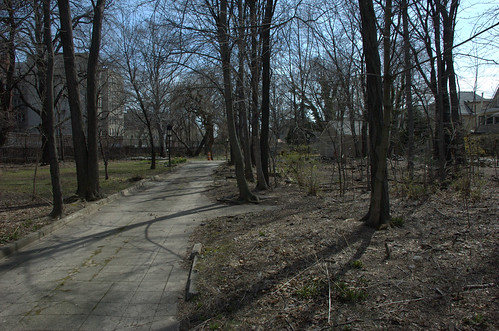
This is the view south down the central drive into the site. The garage is on the right. There’s a lamp post on the left, with Daffodils blooming at its base. Not visible in this photo, the house foundation is to the right.

This is a view southwest, to the right of the central drive. The garage is to the left. The area in front of the garage and extending to the right is where the house stood.

The sunken area in this photo is part of the original foundation of the house.

This view is southeast. You can see the garage in this view, too. Somewhere between the garage and where I stood, behind the fence on the right, is the foundation of the house which stood there.
Most community gardens don’t start with a forest. This presents unique opportunities and challenges. The southern end of the property is already partially cleared and cultivated as gardens. For more residents to grow vegetables, more trees will need to be cleared.
I hope that the northern end, at least, can be kept forested. Many of the trees are likely “weed” trees, invasive species, which can and should be removed. There is already wildlife there, and this part of the property could be preserved as a wildlife and bird refuge and sanctuary. There could be wildflower walks and native plant gardens, cool ferny sanctuaries, shady refuges, and story circles.
The foundation of the old house is largely intact, now largely filled in by a half-century of leaf litter and plant growth. This could be cleared and restored. This could become an educational part of the site, evidence of its history. I have visions of developing it as a sunken garden, a grotto of native plants and ferns, which can fulfill other important educational purposes.
Now that the owner has given their go-ahead, there will be many community meetings and other events for those who want to participate and contribute. I’ll post these here on this blog and add them to the calendar in the sidebar.
Backyard of the Day
Forgotten Flatbush
OASIS online mapping service
Ditmas Park Blog
[where: 1522 Albemarle Road, Brooklyn, NY 11226]
This is 1305 Albemarle Road in the landmarked district of Prospect Park South. The ground floor alone has the square footage of our entire house. It’s the largest house in a neighborhood of huge homes. That alone qualifies it as a “monster house.”
But my favorite feature, for this post: check out the windows on the second floor balcony and dormer:
SPIDER WEBS
I’m out of town this week, so I’m “phoning it in”. If I was home, I would get some detail shots of the 2nd floor and dormer windows. Instead, here are a couple of other views. Visit the Flickr photo pages where you can view these images at their largest sizes and see the windows more clearly.
[where: 1305 Albemarle Road, Brooklyn, NY, 11226]
Update 2007.08.09: The National Weather Service says that this was the strongest tornado on record to hit New York City.
Evening update: By the afternoon, the National Weather Service (NWS) confirmed that there had been an EF2 tornado, but only in the Bay Ridge section of Brooklyn. They also reported that it traveled northeast, which would have placed it in the path of Sunset Park, Kensington, and Flatbush.
Update 16:30 EDT: I’ve got the Flickr set up, and I’m uploading the remainder of the photos as I type.
Totalled. This was on Rugby Road, north of Church Avenue in Caton Park.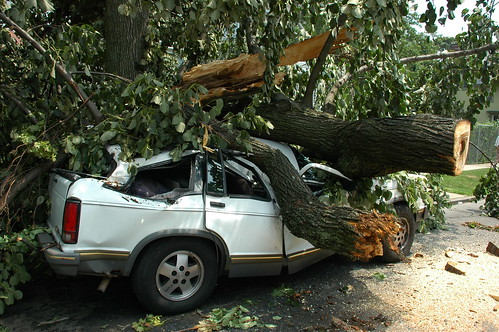
I just got back a half-hour ago from my tornado walking tour of my neighborhood, Beverley Square West, the adjoining Prospect Park South Historic District, and Caton Park. I’m home today because none of the subways were running this morning, and our local line, the B/Q train, is down due to trees on the tracks near the Church Avenue station, around the corner from Prospect Park South, which sustained heavy damage.
Cortelyou Road Station (Q Line), closed
Chainsaws will be serenading us for the next several days. I have lots of photos to upload, once I can clear enough space on my hard drive to accommodate them. I should have plenty by the end of the day, so check back later.
The National Weather Service hasn’t made the determination, but from the reports, and from the damage I saw, I think it must have been a tornado that tore through Brooklyn this morning. When I went out this morning, the local news channels were only covering the neighborhood of Bay Ridge. But later reports include Sunset Park and Kensington. There’s still been no mention of Flatbush on the news, but these neighborhoods form a rough path through central Brooklyn. There’s a track of damage through Brooklyn, not just localized damage, which is just what one would expect to see from a tornado.
Marlborough Road, south of Albemarle Road. Note the two trunks left standing in front of the house on the right; they were both snapped off.
The damage I saw, especially in Prospect Park South, just looked odd. It wasn’t any one thing. There were trees, such as the one at the top of this post, which clearly had problems before they were blown down. Those we would expect to be fall in heavy winds. But there were many trees with clear, clean wood, with no signs of disease or other problems.
Twisted and split limb of Norway maple, 125 Argyle Road
Every kind of tree was affected. Most of the smaller trees were simply blown over, snapped at the root flare, separated from the roots. Some of the larger trees were also toppled, their roots pushing up sidewalks. But many were snapped off at the trunk, or their upper limbs and branches seemed to have been shredded off. I saw large limbs whose damage could only have been caused by twisting. Upper limbs of trees didn’t just fall onto rooftops, they were blown up onto them.
Parks Department beginning to remove a toppled street tree in Beverley Square West.
[bit.ly]
An EF-2 Tornado Strikes Brooklyn on the Central New York Weather Blog of WKTV in upstate New York has some great radar images and the complete text of the National Weather Service’s statement confirming the tornado.
August 16, Brooklyn Eagle: While Bay Ridge Captured Attention, Flatbush Areas Also Suffered from Brooklyn Tornado
August 10, Brooklyn Eagle: The Path of The Brooklyn Twister; Heroic Efforts Help Affected Brooklyn Areas Recover from Tornado Damage includes an excellent map of the path of the tornado
A Tree Blows Down in Brooklyn, photos of damage in Bay Ridge, Brooklyn Row House blog
NYC Hazards: Tornadoes, NYC Office of Emergency Management (OEM)